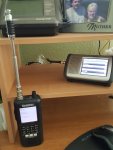You will get a ton of personal opinions on this question. The answers will confuse you more than help.
Fortunately, I have a pile of antennas to test with. Much of what matters has to do with what bands you want to listen to. In my case VHF HIGH, UHF LOW and 800 bands were my target bands. And if you are truly doing a fair test, you need measure your antenna testing in a rock solid stationary position with NO MOVEMENT of the scanner, or your own body, to get fair results. Doing this in a couple of stationary positions will yield even better test results. And you need good weak signals on each band to get meaningful comparisons. Most of the antennas I tested did poorly at one or more of the bands I tested. For example, the much favored Diamond SRH77CA did poorly at 800, and is really tuned for 2m and 70cm ham bands, so that was disqualified. The Radio Shack 800 antenna is great at 800, but not at all acceptable on the other bands. And the Icom stock 2m/70cm antenna did pretty good on 800 and UHF, but not good enough on VHF. A standard telescopic antenna adjusted to 18" does fairly well, but is too bulky and rigid for portable use.
I tested several others that were not winners on all bands. The clear winner in my test was the Comet SMA-24. Unlike the Diamond SRH77CA, which did poorly on 800 MHz, the Comet did fairly well. Not as good as the single band RS 800 antenna, but a fair compromise considering all bands. And VHF/UHF bands did as good as the 18" telescopic antenna, which is about as good as you are going to get other than a single band (coil tuned) half wave, which is exactly what the RS 800 antenna is for 800 MHz(only). But the Comet did better on 800 over the telescopic...unless you shorten the telescopic to around 10 1/2", which is a 50 Ohm 3/4 wave. So something in the small base coil of the Comet works better for 800 than the Diamond. And the VHF/UHF wide-band performance is also not degraded by that matching coil. The SMA-24 is also nice and flexible, so it wins in that category, as well. Works for me!
That's my real world experience. I would like to hear if anyone else did the same type of test with the SMA-24. And if they did, I'd especially like to know if they found a better portable choice that worked at least as well on all bands, but exceeded in some way.
Phil


